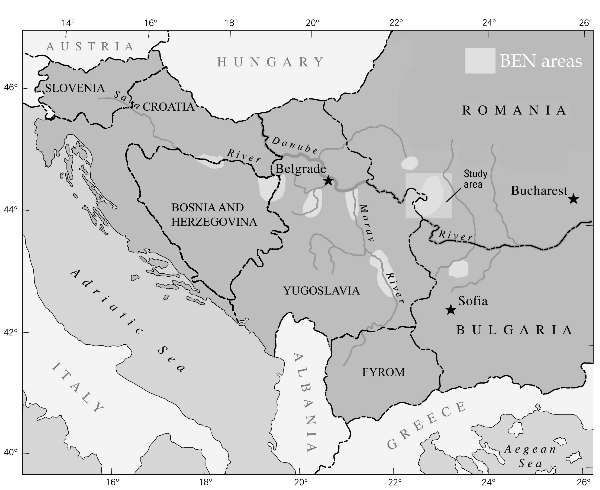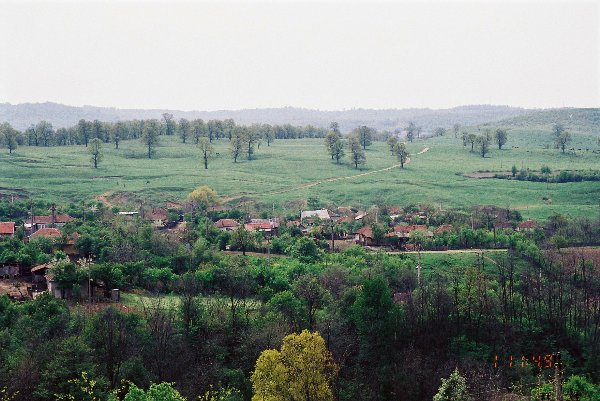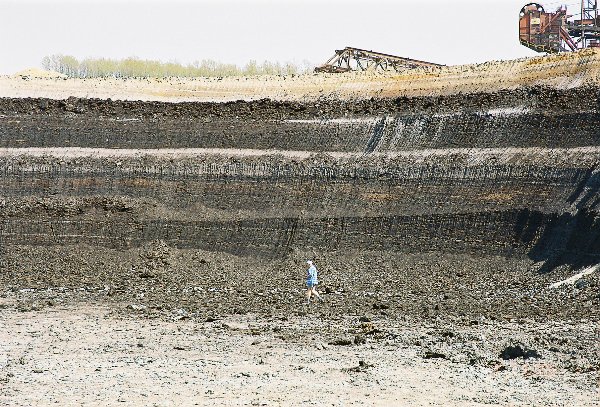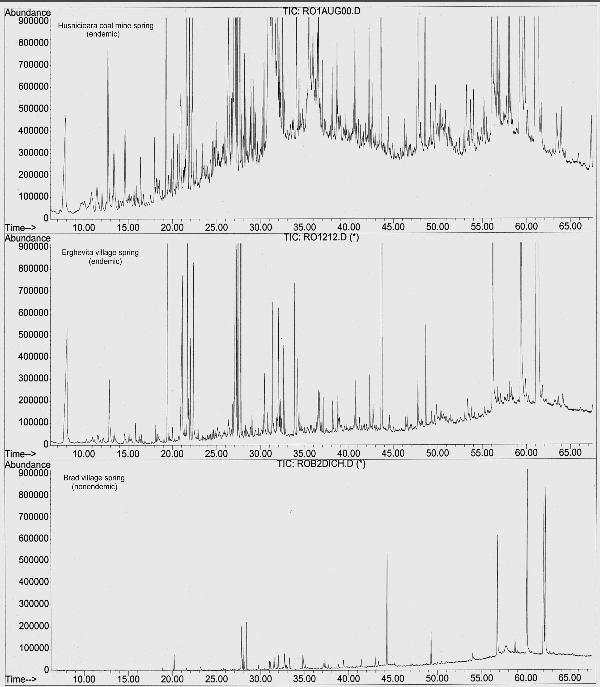|
Discussion Board
Paneles de Discussión
Paneais de Discussio
Free Papers
Comunicaciones libres
Comunicaçoes livres
Home cin2003
Volver al Inicio cin2003
Voltar ao inicio cin2003
|
ENVIRONMENT, MEDICAL GEOLOGY AND THE ETIOLOGY OF BALKAN ENDEMIC NEPHROPATHY
Calin A. Tatu1, William H. Orem2
1Department of Immunology, University of Medicine and Pharmacy.
Timisoara, Romania
2US Geological Survey. Reston, VA, USA
Background
Balkan endemic nephropathy (BEN) is an irreversible, chronic, tubulo-interstitial nephropathy of unknown origin, geographically confined to several rural regions of the Balkan Peninsula. The first "official" observation of a disease resembling BEN was made almost six decades ago in regions comprising the former Yugoslavia (Danilovic et al., 1957). Shortly thereafter, similar descriptions came from Bulgaria and Romania (Radovanovic et al., 2000; Ceovic et al., 1992; Craciun and Rosculescu, 1970). The distribution of BEN includes regions of central and southeastern Serbia, southwestern Romania, northwestern Bulgaria, southeastern Croatia, and parts of Bosnia and Kosovo (Figure 1). The geological setting of the endemic areas in the affected countries is similar. Most of the BEN villages are located on alluvial plains of tributaries of the Danube River, with older Tertiary layers (clays, sands and Pliocene lignites) covered by Quaternary river sediments (Figure 2). It is estimated that several thousand people in the affected countries are currently suffering from BEN and that thousands more will be diagnosed with BEN in the coming years.

Figure 1. Map showing the geographical distribution of the Balkan nephropathy areas.

Figure 2. A typical view for a BEN endemic village from Romania. Although BEN may have existed for centuries in the affected areas, it was acknowledged to the medical community only in the 1950’s when the first epidemic outbreaks were reported. Prior to World War II, average life expectancy in the endemic areas was < 45 years, with major causes of short life expectancy being parasitic or infectious diseases like malaria and tuberculosis. As BEN becomes manifest at older ages (40-50 years), it is possible that the shorter life expectancy in the endemic areas before the war did not allow for a "critical mass" of diseased people to accumulate, and an epidemic kidney disease to be noted. After the war, improvements in sanitation in the affected countries (including anti-malaria and anti-TB measures) coupled with better diagnostic procedures in nephrology made possible the description of BEN, as a distinct nosological entity. BEN was almost simultaneously recognized in all affected countries (in Bulgaria, Tanchev and others in 1956 as reported in Tanchev et al., 1965; in Yugoslavia, Danilovic et al., 1957; and in Romania, Fortza and Negoescu, 1961), and the endemic regions were relatively clearly delimited. The geographic distribution of BEN has not changed significantly since the first descriptions, and villages afflicted in the past continue to be afflicted, while nonendemic villages (sometimes located only a few km from endemic villages) have remained free of the disease ((Plestina, 1992; Theisen, 1995). Reports mentioning a kidney disease resembling BEN in the Balkans have been traced back to the early XXth century. For instance, German doctors documented a large number of deaths from uremia in Serbia in 1915, while in the village of Bistretz (Bulgaria) a disease with the clinical features of BEN was reported in 1910. In Romania, a possible link exists between BEN and familial kidney atrophy observed here in 1905 (Susa, 1976, cited in Radovanovic et al., 2000).
Some of the medical and epidemiological features of BEN are: focal occurrence of the clinical cases; family aggregation without an obvious pattern of mendelian genetic inheritance; long subclinical "incubation" period with a rapid onset of end-stage renal disease (ESRD); at least 10-20 years residence in one or more of the endemic villages; occurrence only in adults (age 30 to 50 being most heavily affected, while almost no children or individuals above 70 develop the disease); a slight sex distribution (female:male ~1.5:1); a similar incidence in different ethnic and religious groups; restriction to a rural, farming population; presence of high blood pressure in only 20% of the affected people; normochromic and normocytic anemia; a very high frequency of upper urinary tract tumors (UTT) in BEN patients. Most epidemiological studies have revealed no obvious differences in the nutritional habits or other significant differences between the endemic and nonendemic households in the same village.
BEN is a slow-evolving disease, characterized by irreversible progression to renal failure and terminal uremia. Once end-stage renal disease is diagnosed in BEN patients, the therapeutical approaches are only symptomatic. As renal transplantation is not a feasible option for most of the BEN patients, hemodialysis is the only approach left. However, kidney transplantation has been attempted in a few people with BEN and no recurrence of the disease has been noted on the transplanted kidneys. Due to adverse economic conditions of the countries affected by BEN, kidney transplantation is not a viable option for the present and near future. The direct consequence of this situation is a poor quality of life for BEN patients in the ESRD phase.
Due to its medical and economical consequences, BEN has been a major research priority through the years, involving multidisciplinary approaches and varied scientific disciplines (e.g., environmental medicine, microbiology, oncology, radiation biology, epidemiology, cytogenetics, geology, hydrogeology, biogeochemistry) and several international symposia have been dedicated to its medical aspects and origins. Despite these research efforts by regional and international scientific groups, BEN is still a medical enigma in many respects, and its etiology a matter of contradiction and controversy. Many factors have been proposed as etiological agents for BEN, including: bacteria and viruses, heavy metals, radioactive compounds, trace element imbalances in the soil, chromosomal aberrations, mycotoxins (ochratoxin A), plant toxins (aristolochic acid), and industrial pollution (for a review see Tatu et al., 1998). Rural villagers in the endemic areas often invoke astrological influences to explain the occurrence of BEN.
In recent years, field and laboratory investigations have supported an environmental etiology for the disease, with a prime role played by the geological background of the endemic settlements (Feder et al., 1991; Tatu et al., 1998; Orem et al., 1999). In this regard, there is a growing body of evidence suggesting the involvement of toxic organic compounds present in the drinking water of the endemic areas. These compounds are hypothesized to be leached by groundwater from low rank Pliocene lignite deposits topographically linked to the endemic villages, and transported into shallow household wells or village springs (Feder et al., 1991; Goldberg M. et al., 1994; Finkelman et al., 1991). The population of villages in the endemic areas uses well/spring water almost exclusively for drinking and cooking, and is therefore potentially exposed to any toxic organic compounds in the water. The presumably low levels of toxic organic compounds present would likely favor relatively slow development of the disease and over a time interval of 10 to 30 years or more. The frequent association of BEN with upper urinary tract (urothelial) tumors suggests the action not only of a nephrotoxic, but also carcinogenic, factor.
Several inorganic and organic geochemical parameters of water and coal samples collected from a Romanian BEN endemic area were assessed by our team during the last several years, in an attempt to find additional links between the environment and BEN etiology, in the frame of medical geology. Some of our more interesting findings are summarized in the following paragraphs.
The setting of the endemic villages
All endemic sites investigated by us are located at elevations below 250 m, in valley bottoms or on plains, and are surrounded by smooth hills. There is usually a main drainage (river or stream) passing through the village that collects smaller drainages originating from the hills. These main drainages are tributaries of the Danube River. Field observations and discussions with villagers indicated that Pliocene lignite deposits exist in the surrounding hills, and that coal mines are in close proximity (less than 1 km) to several endemic villages (Figure 3).

Figure 3. Pliocene lignite mines are sometimes located in close proximity to BEN endemic villages. Inorganic analysis of water samples
Inorganic analysis of water samples collected from endemic and nonendemic sites in Romania did not reveal any significant findings. No consistent differences for anions, nutrients, alkalinity, sulfides, or the general inorganic parameters measured were observed between samples from the endemic and nonendemic sites. Phosphate was somewhat elevated at one of the endemic sites and ammonium was elevated at two of the endemic locations. The relevance of this is unclear, but the higher nutrient concentrations could be attributed to the usage of fertilizers in the area.
On the other hand, nitrate concentrations were elevated in most of the water samples, reaching values as high as 225 mg/l, and exceeding USEPA guidelines for drinking water at all sites. Since no relevant difference was observed between the endemic and nonendemic sites for nitrate, however, it cannot be directly linked to BEN etiology. It is possible though that nitrate is a factor contributing to disease causation in the presence of toxic organic compounds in the water samples. Nitrate can react with various functional groups found in organic molecules (e.g. amino-, hydroxy, etc.), and could increase the toxicity and carcinogenicity of these compounds. Concentrations of metals in the water samples were also generally similar at endemic and nonendemic sites, except for zinc, which appeared to be deficient at the endemic sites.
Organic analysis of water and coal
In contrast to the inorganic geochemistry, dissolved organic constituents in the well and spring water samples collected from the main Romanian BEN endemic area contain a greater number of different compounds (aliphatic and aromatic), and in much higher abundance (>10x), compared to water samples from the nonendemic sites (Figure 4).

Figure 4. Much higher abundances and more organic compounds are found in the endemic vs. the nonendemic water samples. Some of the compounds found in the endemic area water samples were also observed in the water extracts of the Romanian Pliocene lignites (see below), suggesting a possible connection between leachable organics from the coal and organics in the well water samples. The identification of the hundreds of individual compounds in the water samples analyzed by GC/MS is continuing. Preliminary assessment shows the presence of both aliphatic and aromatic compounds, rich in oxygen (hydroxy, phenol, methoxy, aldehyde, keto, carboxy,etc.) and nitrogen (amino) containing functional groups. All the samples, without exception, contained various phthalates, which are some of the most common man-made environmental contaminants. Pesticides were absent except for one nonendemic water samples where compounds from the atrazine family were found in μg/l concentration.
Based on the hypothesis that water is the carrier of the BEN causing agent, we conducted laboratory water extraction of different coals as an experimental model for their natural bioavailability. We demonstrated in earlier work (Tatu et al., 2000a; Tatu et al, 2000b) that methanol extracts of Pliocene lignites from the endemic area have a geochemical signature distinct from that of higher rank coals, and characterized by a much higher number and abundance of organic compounds from GC/MS total ion current plots . Methanol extracts of the Pliocene lignites from the endemic areas also appear to be distinct from methanol extracts of other lignites collected from areas in Romania free of BEN.
The complexity of the dissolved organics in water extracts of the endemic area Pliocene lignites is obvious, and it is not matched by any of the nonendemic area lignites analyzed. The total ion current of water extracts of the endemic area lignites show peaks corresponding to aliphatic (mainly cycloalkanes/alkenes and steranic structures) and aromatic (mono- and polyaromatic terpanes, polycyclic aromatic hydrocarbons) compounds. Many of these compounds have attached oxygen-based functional groups (hydroxy-, phenol-, keto-, methoxy-) and some of them contain heterocyclic nitrogen or amino groups, structural features that could make them nephrotoxic and carcinogenic. Very few of these components are encountered in the methanol extracts of lignite from the nonendemic areas. This difference could be due to distinctive paleogeographic coal- forming conditions during the last period of the Tertiary in the corresponding BEN endemic and nonendemic areas (Tatu et al., 2000b).
The endemic area Pliocene lignites also have much more water-soluble organic compounds compared to higher rank coals. The room temperature water extraction process seems also to be time dependent, the 4 months water extract having a double amount of organics compared to the one month extract. All of the individual components have not yet been identified, but they are mainly aromatic and aliphatic and it is likely that many of them overlap with those from the methanol extracts. Similar experiments are underway using nonendemic area Pliocene lignites.
Conclusive remarks
The first etiological hypothesis for BEN, advanced by Danilovic in Yugoslavia was that the disease is a chronic intoxication with lead, originating from the milling wheels used to ground wheat and contaminating the flour consumed by the villagers in the endemic area (Danilovic et al., 1957). This suggestion was taken seriously by local authorities from Serbia, who banned the use of the watermills in the area. This measure led to serious economic losses for the villagers who had to travel to other localities to grind their grains, but no reduction in BEN incidence was noted in the affected areas (Radovanovic et al., 2000). Subsequent laboratory investigations carried out in the countries affected by BEN failed to confirm any role for lead in the causation of BEN. In addition, the clinical picture of the BEN patients lacked the elements defining lead intoxication.
Except for the nitrate concentrations, which were found to be high in both the endemic and the nonendemic water samples, all the other inorganic parameters measured by us showed no strikingly high or low values for the endemic and the nonendemic locations.
The organic geochemical information obtained from our study in the BEN areas is consistent with the Pliocene lignite hypothesis of BEN etiology: however, although this does bring a geomedical explanation for BEN causation, it still fails to provide a final confirmation to this theory. A "smoking-gun", imagined as an organic molecule with known nephrotoxic and/or carcinogenic properties, is still missing, but the presence of much more potentially toxic organic contaminants and in much higher concentrations in the endemic vs. nonendemic water samples is an encouraging finding, which by itself should justify further field work in the affected countries.
In addition, we have demonstrated that the Pliocene lignites from the BEN areas produce a much greater yield of organic substances in polar extracts compared to higher rank coals and compared to other lignites from nonendemic areas in Romania. These compounds include PAH’s, and highly functionalized (O,N, and S) aliphatic and aromatic compounds. Some of these compounds were also identified in the water samples collected from the endemic villages. It may be that only a small number of compounds (perhaps even only one type of structure) out of the hundreds in the water samples is responsible for BEN and the associated UTT’s. Moreover, the relatively low concentrations of toxic organic compounds found in the drinking waters (individual compounds generally < 1 μ
g/l) in endemic villages could explain the long period of exposure (decades) leading to BEN.
As the GC/MS method of identifying organic compounds is limited to molecular weights <600 Da, it is likely that some higher molecular weight compounds present in the water samples have remained undetected. Of particular interest from this standpoint are humic substances. There are some studies reporting a potential toxicity of humic substances present in ground water and bioavailable to human populations. Certain humic acids have even been implicated in the etiology of black foot disease and Kashin-Beck disease in China (Hseu et al., 2000; Liang et al., 1998), and a similar implication cannot be excluded in BEN, the more so as the presence of humic substances in the ground water from the BEN areas is almost a certainty. Such compounds can also be leached from low rank coals like Pliocene lignites and we plan to identify them by HPLC-MS in further experiments.
The clinical, scientific and environmental health importance of BEN is not limited by the relatively small number of affected persons, or by the seemingly small extent of the affected regions. As intriguing as its etiology and epidemiology is, BEN could still be considered a local problem, affecting just a discrete part of Europe. However, there are at least four reasons (Radovanovic et al., 2000) why BEN has a universal relevance for the scientific and medical community:
- The medical geography of BEN is not completely clarified. Although traditionally described in only in a few Balkan countries, kidney diseases similar in etiology to BEN could occur unrecognized on a more or less endemic scale in other regions of the world. This is true not only for regions with low rank coal deposits such as the Pliocene lignites linked to BEN, but also for anywhere where groundwater used for drinking or cooking is in proximity to coal or coal waste stored near power plants or mines. Since coal is a major source of energy worldwide, there is a large potential for contamination of groundwater and surface water by toxic organic compounds from coal (Finkelman, 2000). BEN-like kidney diseases could remain unrecognized due to factors such as population mobility, short life expectancy in an exposed population, or deficient local medical systems. Also, point sources of contamination, such as coal stored next to a power plant, may affect much smaller areas than occurs with BEN.
- Discovering the cause of BEN and revealing its etiopathogenic mechanisms will lead to a better understanding of other kidney diseases, such as analgesic and cadmium nephropaties and of the end stage renal disease. ESRD poses a significant economic burden in many countries, translated into costs for renal dialysis and kidney transplantation. As for many ESRD patients the primary cause of the chronic renal failure is unknown, effective preventive measures cannot be considered in this case.
- The emergence of UTT’s in BEN patients has often been attributed to the same etiologic agent(s) causing BEN itself. Thus, identification of this agent(s) may provide insight into the etiology of cancer as well as ESRD.
- From a humanitarian standpoint, identifying the BEN causal factor, will allow preventive measures to be adopted in the directly afflicted countries, such as by treatment or filtration of the drinking and cooking water or changing the main water supply as has already been done in several endemic regions in Serbia. Such measures could prevent another generation of BEN patients from developing.
Although appealing, the Pliocene lignite implication in BEN etiology is still a possibility rather than a certainty. BEN cause probably resides in the complexity of the environment where the disease occurs and a combination of external factors acting together on a susceptible genetic makeup should be considered. Organic compounds found in the groundwater are a potential major culprit, but their source remains elusive; their origin in the Pliocene lignite is likely but the fact that not all the described endemic areas are topographically connected to known Pliocene coal beds (i.e., one endemic area in Serbia and the endemic area in Bulgaria) rises further questions about this possibility. Uncharted and of low economic importance Pliocene coal deposits could be an explanation in this case, as is the situation of the smaller endemic area in Romania (Resita region). However, more extensive geochemical investigations and perhaps some novel methodological and conceptual approaches will be needed in order to answer the main question, that of Balkan nephropathy etiology.
Acknowledgments
Support for this work was provided through a grant from the US Geological Survey and collaborative linkage grants (EST.CLG.975818 and EST.CLG.977806) from NATO to W.H.Orem, an assistance award (00HQAG0213) from the US Geological Survey to C.A. Tatu and through funding from the Romanian Ministry of Health. We are grateful to Anne Bates, Margo Corum and Marisa Beck, from the US Geological Survey, for assistance with the inorganic analysis. References
Ceovic S., Hrabar A. and Saric M.: 1992, Epidemiology of Balkan Endemic Nephropathy. Food and Chemical Toxicology 30,183-188.
Craciun, E. and Rosculescu, I.: 1970, On danubian endemic familial nephropathy(Balkan nephropathy). American Journal of Medicine 49,774-779.
Danilovic V., Djurisic M., Mokranjac M., Stojimirovic B., Zivojinovic J. and Stojakovic, P.: 1957, Chronic nephritis caused by poisoning with lead via the digestive tract (flour). Presse Medicale 65,2039-2040[in French].
Radovanovic, Z., Sindic, M., Polenakovic, M., Dukanovic, L. and Petronic, V.: 2000, Endemic nephropathy. Zavod za Udzbenike i Nastavna Sredstva, Beograd. 447 pp.
Tanchev, Y., Naidenov, D., Dimitrov, T. and Nikolov, B.: 1965, Health centre control of patients suffering from endemic nephropathy in Vratza District. In: A. Puchlev, N. Popov, A. Astrug, D. Dotchov and I. Dinev (eds.) International Symposium on Endemic Nephropathy. Bulgarian Academy of Science Press, Sofia, pp.142-148.
Plestina, R.: 1992, Some features of Balkan endemic nephropathy. Food and Chemical Toxicology 30,177-181.
Theisen, J.: 1995, Balkan turmoil delays BEN research: Disease links to weathered low-rank coals remain speculative. TSOP Newsletter 12, 5-7.
Fortza, N. and Negoescu, M.: 1961, Nefrita cronica azotemica endo-epidemica. Studii si Cercetari Medicale 1, 217-221[in Romanian].
Orem, W.H., Feder, G.L., and Finkelman, R.B.: 1999, A possible link between Balkan Endemic Nephropathy and the leaching of toxic organic compounds from Pliocene lignites by groundwater. International Journal of Coal Geology 40, 237-252.
Tatu, C.A., Orem, W.H., Finkelman, R.B. and Feder, G.L.: 1998, The etiology of Balkan endemic nephropathy: still more questions than answers. Environmental Health Perspectives 106, 689-700.
Tatu, C.A., Orem, W.H., Feder, G.L., Finkelman, R.B., Szilagyi, D.N., Dumitrascu, V, Margineanu, F., and Paunescu, V.: 2000a, Additional support for the role of the Pliocene lignite derived organic compounds in the etiology of Balkan endemic nephropathy. Journal of Medicine and Biochemistry 4, 95-101.
Tatu, C.A., Orem, W.H., Feder, G.L., Paunescu, V., Dumitrascu, V., Szilagyi, D.N., Finkelman, R.B., Margineanu, F., and Schneider, F.: 2000b, Balkan endemic nephropathy etiology: a link to the geological environment. Central European Journal of Occupational and Environmental Medicine 6, 138-150.
Feder, G.L., Radovanovic, Z. and Finkelman, R.B.: 1991, Relationship between weathered coal deposits and the etiology of Balkan endemic nephropathy. Kidney International 40 (Suppl. 34),S9-S11.
Finkelman, R.B. (2000) Health impacts of coal combustion: US Geological Survey Fact Sheet, FS-094-00.
Finkelman, R.B., Feder, G.L., Orem, W.H. and Radovanovic, Z.: 1991, Relation between low-rank coal deposits and Balkan Endemic Nephropathy. Association of Geoscientists for International Development News #65, 23.
Goldberg, M.C., Feder, G.L. and Radovanovic, Z.: 1994, Correlation of Balkan endemic nephropathy with fluorescent organic compounds in shallow ground water. Applied Hydrogeology 2,15-23.
Hseu, Y.C., Lu, F.J., Engelking, L.R., Chen, C.L., Chen, Y.H., Yang, H.L.: 2000, Humic acid-induced echinocyte transformation in human erythrocytes: characterization of morphological changes and determination of the mechanism underlying damage. Journal of Toxicology and Environmental Health 60,215-230.
Liang, H.J., Tsai, C.L., Lu, F.J.: 1998, Oxidative stress induced by humic acid solvent extraction fraction in cultured rabbit articular chondrocytes. Journal of Toxicology and Environmental Health 54, 477-489.
|
